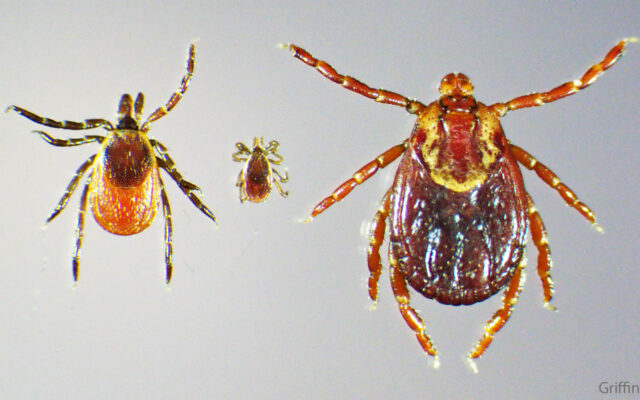
Maine’s dog tick population is exploding this spring
By Julia Bayly, Bangor Daily News Staff
There is an explosion in the dog tick population this spring, experts say. It appears a relatively mild winter, last summer’s dry conditions and the overall hardiness of the tick itself created ideal dog tick conditions.
The dog tick gets its name from the fact that it prefers to feed on domestic dogs. This is a different species from the smaller black legged — or deer — tick that carries Lyme disease. Dog ticks are twice the size of deer ticks and can be identified by a reddish-brown shield on its back at the base of the head.
“We are seeing some really astronomical numbers,” said Griffin Dill, who manages the tick lab at the University of Maine Cooperative Extension Diagnostic and Research Laboratory. “Last year at this time we had reports in the single digits and so far this year I have received well over 300 reports.”
According to Dill, dog ticks are considered a nuisance pest in Maine. Their bite can cause reactions in humans ranging from minor itching around the bite area to some localized pain. Dill did say dog ticks can carry and transmit the disease Rocky Mountain Spotted Fever, but to date no pathogen-carrying dog ticks have been reported in Maine.
This is very different from the seriousness of a bite from a lyme disease carrying deer tick. So far, the deer tick population in Maine is not showing an increase this season.
“The number of ticks are robust in Maine, but not much different than in the past couple of years,” Dill said. “We are just not seeing the same activity as we are with the dog ticks.”
Dog ticks hang out in wooded, bushy and grassy areas. You or your pet can easily come into contact with them while outside. The tick can attach itself to the living host — like you or your pet — and then bury its head in your body or your pet’s body. It will then stay there and feed on blood for up to several days until it is fully engorged. Then it falls off.
Dill urges anyone who spends any time outside to conduct regular tick checks on themselves and their pets when they get back inside. And to keep in mind a tick can latch on to virtually any body part. They prefer warm, moist areas on your body so pay special attention to under your arms, behind your knees, in and around your ears, your belly button and your groin area.
“If you have a tick on you that has already attached, the best method to remove them is using tweezers,” Dill said. “Pull the tick with slow, steady pressure to avoid breaking off the head or mouth.”
If the head or mouth does break off and remains under the skin, Dill said there is no reason to panic. Your body will treat it as a splinter and expel it on its own.
“New research is showing that you can do more harm than good by trying to dig the head or mouth piece out yourself,” Dill said.
Once the tick is completely removed, Dill said you should clean the bite area with antibiotics or anti-itch creams.
To help avoid tick encounters in the first place, the Maine Center for Disease Control and Prevention recommends using EPA-approved repellents, walking in the center of trails, trying to avoid wooded or bushy areas with tall grass, wearing long-sleeved shirts, tucking your pant legs into your socks and tucking your shirt into your pants.
To keep your pets safe, consult with your veterinarian on approved flea and tick products. Then make sure to use it according to the instructions.
Dill admits ticks are a nuisance at best and potential health issue at worst in Maine, but he also does not want to see people staying inside all summer to avoid them.
“We want people to get outside and enjoy all the outdoors Maine has to offer,” he said. “Use repellents, avoid areas where ticks are and make sure to do your tick checks when you get back inside.”
In terms of the dog ticks, the good news is the worst may soon be over.
“We generally see the peak in dog tick activity in mid May to June and then it trails off and is pretty much done by mid September,” Dill said. “We just might be seeing an earlier peak this year and I hope it’s not an extended peak, but that remains to be seen.”